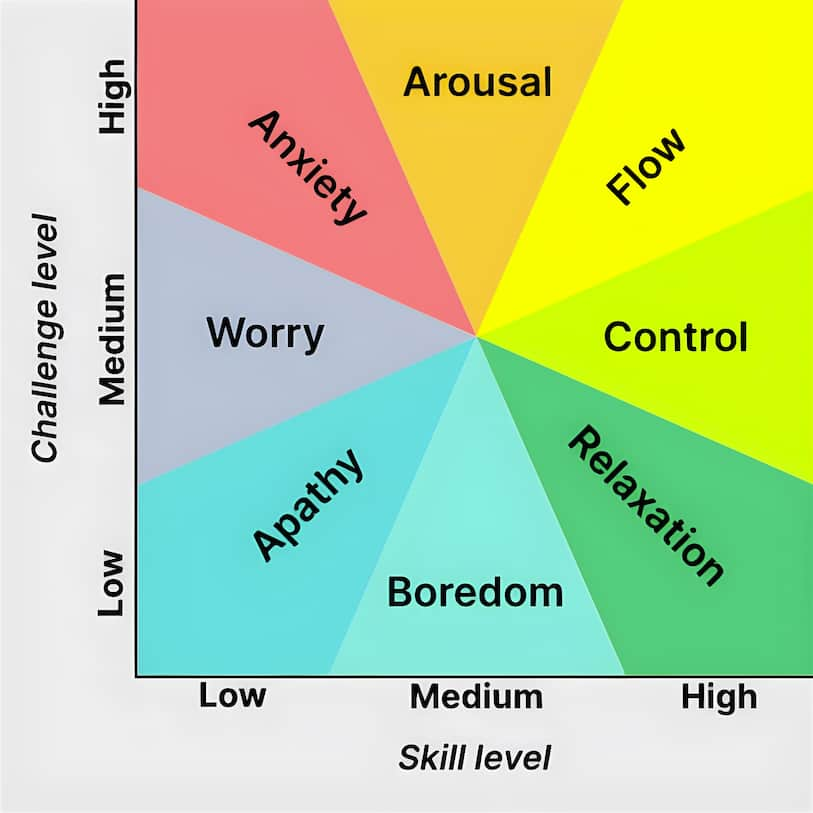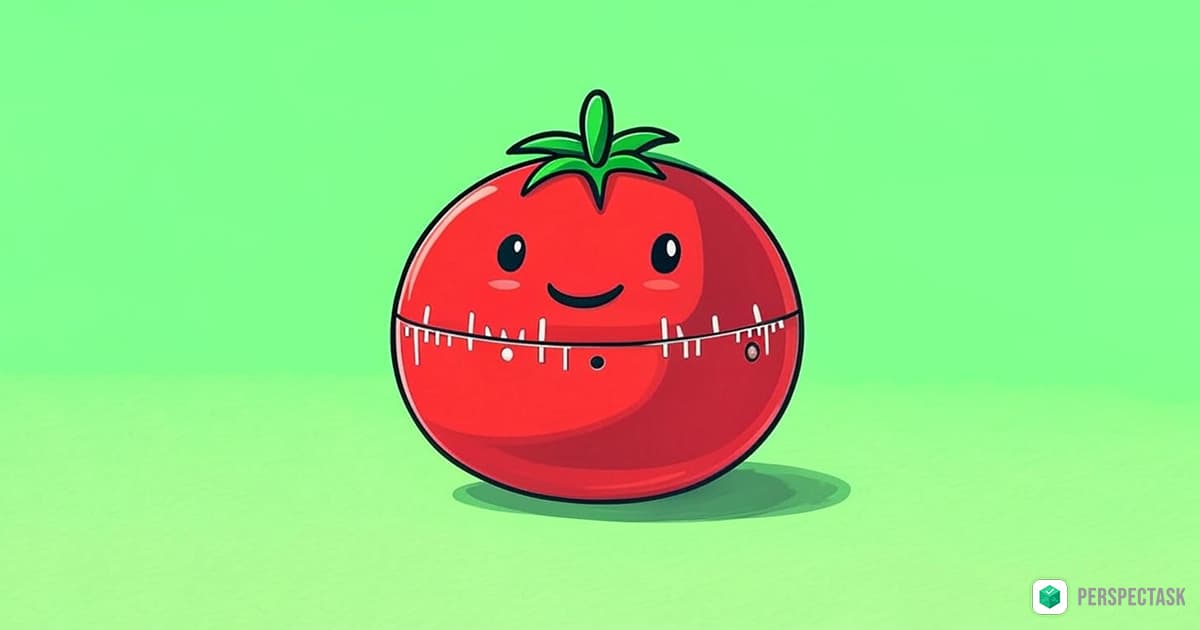Ever feel like you're just going through the motions?
Like your days blur together in a haze of boredom, anxiety, and vague dissatisfaction? You chase happiness through external things – money, status, fleeting pleasures – but it always seems just out of reach.
What if I told you there's a state you can cultivate, an experience so engrossing that time melts away, your skills are perfectly matched to the challenge, and you feel a deep sense of enjoyment and control?
This isn't some mystical pipe dream.
It's a scientifically documented state called Flow, and understanding it might just be the key to unlocking a richer, more meaningful life.
This guide dives deep into the concept of Flow, drawing heavily from Mihaly Csikszentmihalyi's classic work. You'll learn not just what Flow is, but how to find it in your own life, turning even mundane tasks into sources of profound satisfaction.
Let's get into it:
What is Flow (and Why Is It Your Secret Weapon)?
Think back to a time when you were completely absorbed in something. Maybe it was playing an instrument, coding a complex piece of software, having a deep conversation, or even just tackling a challenging project at work.
You weren't distracted. You weren't bored. You weren't worried about failure. You were just... doing.
That feeling? That's Flow.
Csikszentmihalyi defines Flow as "the state in which people are so involved in an activity that nothing else seems to matter; the experience itself is so enjoyable that people will do it even at great cost, for the sheer sake of doing it."
Here's the deal: Flow isn't about passive relaxation. It's not about vegging out in front of the TV (which, studies show, rarely leads to flow and often leaves us feeling worse).
Flow comes from active engagement, from stretching your body or mind to its limits in a voluntary effort.
And here's why it's crucial:
- Happiness Isn't External: True happiness isn't something that happens to you based on external conditions (wealth, power, looks). It's an internal state you cultivate by controlling the contents of your consciousness. Flow is the optimal state of inner experience.
- Enjoyment vs. Pleasure: There's a huge difference. Pleasure satisfies biological needs or social conditioning (eating when hungry, relaxing after work). Enjoyment involves novelty, accomplishment, exceeding expectations, and personal growth. Flow activities provide enjoyment.
- Growth of the Self: When you're in flow, you're becoming more complex. You're differentiating your skills and integrating yourself more deeply with the activity and the world. Flow builds the self.
Bottom line? Learning to experience Flow consistently is the most direct path to improving the quality of your life.
The 8 Ingredients of Deep Enjoyment (The Flow Recipe)
So, what does Flow actually feel like? And what conditions make it happen?
Across thousands of interviews with people from all walks of life – artists, athletes, surgeons, workers, teenagers, elderly people from different cultures – Csikszentmihalyi identified eight consistent components of the Flow experience:
- Clear Goals: You know exactly what needs to be done, moment by moment. Whether it's hitting the tennis ball back over the net, writing the next line of code, or figuring out the next step in a complex negotiation, the objective is unambiguous.
- Immediate Feedback: You can tell how well you're doing as you go. The tennis ball lands in or out. The code compiles or throws an error. The other person nods in understanding or looks confused. This constant feedback loop lets you adjust your actions instantly.
- A Balance Between Challenges and Skills: This is crucial, and we'll explore it more visually in the next section. The task has to be challenging enough to hold your attention, but not so difficult that it causes anxiety. Your skills need to be sufficient to meet the challenge, but not so high that you get bored. Flow lives on the razor's edge between boredom and anxiety.
- Action and Awareness Merge: You stop being aware of yourself as separate from the action you're performing. Thought and action become one seamless movement. You're not thinking about playing the piano; you are the playing.
- Concentration on the Task at Hand: Intense focus comes naturally. Distractions fade away. Worries about bills, relationships, or your to-do list disappear because there's simply no room left in your awareness.
- A Sense of Potential Control: You feel like you can handle the situation, that you have the necessary skills to influence the outcome. This isn't about absolute control (you might still lose the game), but about lacking the usual worry about losing control. Even in risky activities, the enjoyment comes from exercising control over potentially dangerous forces.
- Loss of Self-Consciousness: Concerns about how you look or what others think vanish. Your ego quiets down. Paradoxically, after the flow experience ends, your sense of self often emerges stronger and more complex because you've pushed your boundaries.
- Transformation of Time: Your subjective experience of time alters. Hours can feel like minutes, or seconds can stretch out. Clock time becomes irrelevant.
When these conditions are present, the activity becomes autotelic – intrinsically rewarding, done for its own sake rather than for some external outcome. This is the heart of Flow.
Visualizing Flow: The Challenge vs. Skill Balance
One of the most powerful ways to understand Flow is through a simple visual model. Imagine a graph where the vertical axis represents the level of Challenge you perceive in an activity, and the horizontal axis represents your level of perceived Skill.

Your mental state depends on where you fall on this graph:
- The Flow Channel (Top Right Quadrant): This is where the magic happens. When challenges are high and your skills are high enough to meet them, you enter the state of Flow (Yellow). You feel engaged, focused, and deeply satisfied. Adjacent states like Arousal (Orange, high challenge slightly outweighing skill) and Control (Light Green, high skill slightly outweighing challenge) are also positive and often precede or follow true Flow.
- Anxiety & Worry (Top Left Quadrant): When challenges are high, but your skills are low, you feel overwhelmed. This leads to Anxiety (Red) or Worry (Greyish Blue). You're likely to feel stressed and out of control.
- Boredom & Apathy (Bottom Left Quadrant): When both challenges and skills are low, you drift into Apathy (Light Blue). Nothing is engaging, nothing demands your attention, and you feel dull and disinterested. If skills are slightly higher but challenges remain low, you experience Boredom (Aqua).
- Relaxation (Bottom Right Quadrant): When skills are moderate or high, but challenges are low, you might feel Relaxation (Green). This can be pleasant, but it lacks the engagement and growth potential of Flow.
Now, here's the critical insight: This isn't static. To stay in Flow, you constantly need to adjust the balance.
- If you're feeling Bored or too much in Control, you need to increase the Challenges. Take on a slightly harder task, set a more ambitious goal, add a new constraint.
- If you're feeling Anxious or Worried, you need to increase your Skills. Practice more, learn new techniques, break the task down into smaller steps you can handle.
This model shows why Flow leads to growth. The drive to stay in that enjoyable state pushes us to constantly improve our skills and seek out greater challenges, making us more complex individuals over time.
Finding Your Flow: Turning Everyday Life into an Adventure
Okay, this sounds great in theory. But how do you apply it when you're not a rock climber or a concert pianist?
Here's the exciting part: You don't need extreme situations to experience Flow. You can find it in your daily work, your leisure time, even when you're alone.
Flow at Work:
Consider the example Csikszentmihalyi gives of a welder named Joe working in a railroad car assembly plant. The job itself was repetitive, noisy, and physically demanding – seemingly the opposite of enjoyable. Yet, this welder transformed it into a flow activity. He constantly challenged himself to improve his technique, to make his welds faster and cleaner, essentially turning the routine into a personal craft. He learned every phase of the plant's operation and could fix any machine, finding intrinsic rewards in solving these mechanical puzzles. He saw challenges and opportunities for skill development where others saw only drudgery.
This highlights a crucial point: Work often has more potential for flow than leisure. Why? Because jobs usually have built-in goals, rules, feedback mechanisms, and challenges.
The problem? We often approach work with the wrong mindset, seeing it only as a means to an end (paycheck, status) rather than an opportunity for engagement and growth. We feel forced, alienated, and wish we were doing something else, even when the experience itself is positive.
- How to fix this?
- Adopt an Autotelic Attitude: Like the welder, look for hidden opportunities for action within your tasks. Set personal challenges: Can you improve efficiency? Can you learn a new aspect of the job? Can you find ways to make the routine more skillful or elegant?
- Structure Your Tasks: Break down large, vague projects into smaller, concrete steps with clear goals and feedback points. This makes challenges manageable and highlights progress.
- PerspecTask Tip: Use PerspecTask to break down massive work projects into actionable daily or weekly subtasks. The unlimited hierarchy lets you get as granular as you need to perfectly balance challenge and skill. Track progress automatically with the percentage completion indicators – instant feedback! Use the built-in timer to maintain focus and see exactly where your work energy goes.
Flow in Leisure:
This is where we often waste the biggest opportunity. We have free time, but fill it with passive consumption – endless TV, scrolling social media. These activities rarely challenge us or use our skills, leaving us feeling apathetic, weak, and dull.
- How to fix this?
- Choose Active Leisure: Opt for hobbies and activities that require skills and concentration – playing music, gardening, writing, learning a language, playing strategic games, engaging in sports. These activities naturally provide the structure needed for Flow.
- Set Leisure Goals: Don't just passively consume. Decide what you want to achieve in your free time. Learn a specific song on the guitar. Read a challenging book and discuss it. Master a new cooking technique. Even leisure needs goals to become truly enjoyable.
- PerspecTask Tip: Treat your hobbies and personal growth like important projects. Create tasks in PerspecTask for practicing skills, reading specific chapters, or completing creative projects. Schedule them in the Day or Week views just like work tasks. The visual progress will keep you motivated and provide clear feedback.
Flow in Solitude & Relationships:
Most people dread being alone. Without external demands, the mind drifts into chaos (psychic entropy), focusing on worries and anxieties. Learning to enjoy solitude by engaging in challenging activities (reading, thinking, hobbies, working on personal projects) is crucial for developing a disciplined, complex self.
Relationships, while often our greatest source of happiness, can also be our greatest source of pain. To make relationships flow, they need active investment:
- Shared goals (both long-term, like building a life together, and short-term, like planning a weekend activity).
- Open communication (providing clear feedback on feelings and needs).
- Finding new challenges together (deepening understanding of each other, exploring shared interests, tackling life projects like raising children or building a home).
- Balancing differentiation (supporting each other's individual growth) and integration (maintaining connection and mutual support).
- PerspecTask Tip: Manage shared goals like household projects or vacation planning in PerspecTask. Use the Life or Year views to map out long-term personal growth goals that require focused time, helping you structure and protect your valuable solitude for deep work or learning.
Cheating Chaos: Turning Stress into Strength
Life inevitably throws curveballs – setbacks, disappointments, tragedies. What separates those who crumble from those who grow stronger?
It's the ability to transform adversity into a manageable, even enjoyable, challenge. People who do this possess what Csikszentmihalyi suggests is an autotelic self – a self whose goals primarily originate from within, based on personal experience and evaluation, rather than being dictated solely by biology or social convention.
How do they do it? They develop "transformational coping skills," essentially turning potential psychic entropy into flow. This involves three key steps:
- Unselfconscious Self-Assurance: Trusting your ability to cope without being rigidly self-centered. Seeing yourself as part of a larger system and working with the situation (like a pilot working with the plane and the weather) rather than insisting on your own way against all odds. It requires humility and flexibility.
- Focusing Attention Outward: Instead of getting trapped in internal worries and fears (which isolates you and reduces options), paying close attention to the external reality of the situation. This reduces internal chaos and allows you to perceive opportunities and constraints objectively, finding new ways to act.
- Discovering New Solutions: Being open to finding alternative goals and paths when the original ones are blocked. This requires evaluating events based on your actual experience and potential for growth, not just on preconceived notions of what should happen or what you thought you wanted.
Developing these skills means adversity doesn't just have to be endured; it can become a catalyst for growth and deeper meaning.
The Ultimate Game: Weaving Flow into a Meaningful Life
Experiencing flow in isolated activities is great. But the ultimate challenge is to weave these threads together, transforming your entire life into a unified flow experience.
How? By finding or creating a life theme – an overarching purpose that gives significance to all your smaller goals and actions. This theme acts like the ultimate game, providing rules and direction for your entire existence.
This requires:
- Purpose: Identifying an ultimate goal that is challenging and personally compelling enough to organize your psychic energy over the long term. This could be based on religious faith, scientific inquiry, artistic creation, building a family, fighting for a cause, mastering a complex domain of knowledge, or striving for spiritual integration.
- Resolution: Committing to this purpose and pursuing its challenges with determination, even in the face of obstacles or tempting alternatives. Effort justifies the goal, and the goal justifies the effort. This resolve turns intention into meaningful action.
- Harmony: Achieving inner congruence where your feelings, thoughts, and actions are aligned with your purpose. This requires self-knowledge, often gained through both action (vita activa) and reflection (vita contemplativa) – understanding what you truly enjoy and value, and why.
Finding such a purpose isn't easy in our modern world of overwhelming choices. It often requires deep reflection ("Know thyself") and drawing wisdom from the accumulated knowledge of culture – literature, art, philosophy, religion, science. It might involve discovering your theme through personal experience, perhaps even transforming past suffering into a future challenge dedicated to helping others facing similar plights.
Your Turn to Flow
You don't have to be a Zen master or a world-class athlete to experience the deep focus, enjoyment, and growth that Flow provides. It's available right here, right now, in the activities that fill your days.
The key is taking control of your consciousness. It means setting clear goals, finding the right balance of challenge and skill, focusing your attention, and seeking activities that reward you intrinsically. It means turning chaos into order, both within your mind and in your life.
Ready to stop drifting and start flowing?
The principles are clear, but putting them into practice requires discipline. You need a system to define your goals, break down challenges, track your progress, and manage your most precious resource – your attention.
That's exactly why PerspecTask was built.
- Set Clear Goals: Define your Life Theme in the Life view, break it down into Yearly, Monthly, Weekly goals, and finally into concrete Daily tasks. PerspecTask's multi-perspective view makes connecting daily actions to your ultimate purpose seamless.
- Balance Challenge & Skill: Use the unlimited subtasks to break down daunting challenges into manageable steps that match your current skills. As your skills grow, add more complex subtasks. The hierarchy keeps challenges organized.
- Get Immediate Feedback: Watch the progress bars fill up automatically as you complete subtasks. See your daily, weekly, and monthly progress at a glance in the Period Views. Know exactly where you stand.
- Concentrate: Use the built-in timer on each task to focus your attention and block out distractions. See your total focused time grow each day, reinforcing your commitment.
- Gain Control: Organize your entire life, from grand ambitions to daily chores, in one secure, end-to-end encrypted space where you define the meaning and purpose.
Stop letting life just happen to you. Start designing your experience. Start finding your flow.
Sign up for your free PerspecTask trial today and begin transforming your life into an optimal experience!
Ready to apply these productivity methods?
PerspectTask helps you implement these techniques in your daily workflow for maximum efficiency.
Start for Free →Pro two-week trial · No credit card required · Free forever plan available

